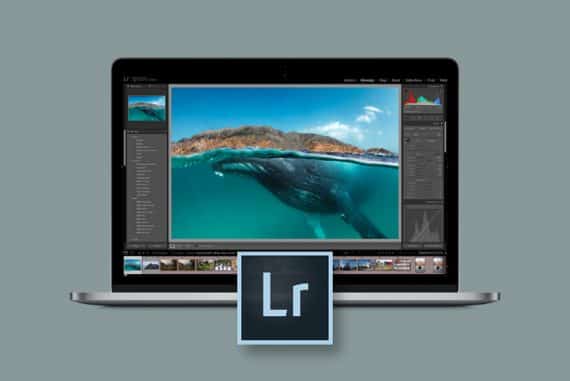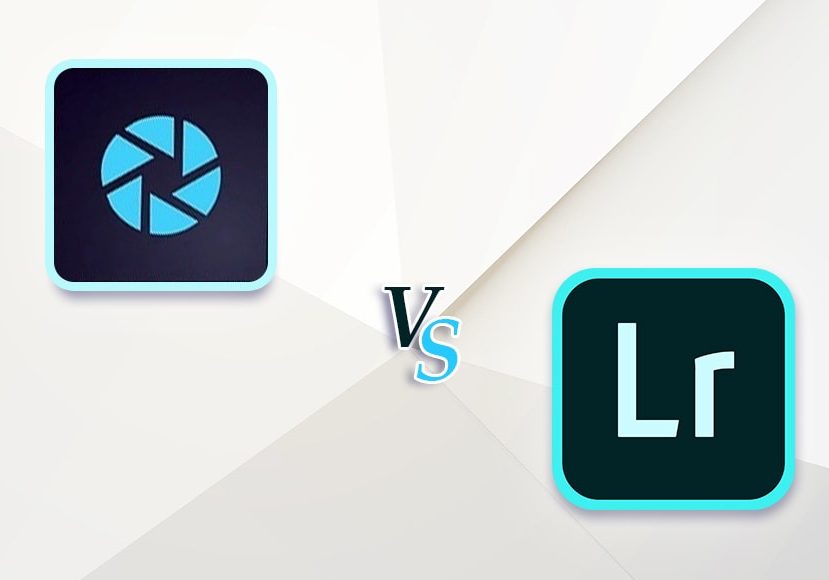
Photoshop Elements vs Lightroom (7 Differences in 2023)
The expensive subscription cost of Adobe Lightroom makes Photoshop Elements an attractive option. Compare Photoshop to Elements to see which is better.
Lightroom | Photoshop Elements | Software | By Usnea Lebendig and Mark Condon | Last Updated: April 20, 2023
Adobe Photoshop Elements is very different from Lightroom Classic, but if you’re new to the world of photo editing, which should you choose?
Both Elements and Lightroom are great image editors, but each was designed for a specific audience and purpose.
(And one is notably cheaper than the other one too!)

Download the latest version of Adobe Photoshop Elements to follow along with this simple tutorial.
Whether you’re on a tight budget or just want the simplest way to start editing your pictures, one of these apps will be perfect for you.
…but first, we need to compare Photoshop to Elements from the eyes of a new user.
Let’s take a closer look at what these two great apps offer and who should use them.
Table of Contents
Photoshop Elements vs Lightroom Classic: Key Differences
Here’s a quick look at the differences between Elements and Lightroom:
1. Adobe Photoshop Elements was created for beginners who dabble in both photography and graphic arts.
It’s dubbed as a lighter version of Photoshop and offers a picture organizer with artificial intelligence, a photo editor, layers, special effects, and print tools.
If you’ve never used editing software before, it’s a fantastic place to start.
The best thing about Photoshop Elements is that you can buy it outright – this means you only need to pay for it once, and you’ll own it forever.
Currently, Elements is the only Adobe product that you don’t need to subscribe to, and that makes it incredibly attractive.
See also our guide on the differences between Photoshop Elements and Photoshop.
2. Adobe Photoshop Lightroom was designed for professional photographers and serious amateurs.
It provides advanced non-destructive editing, streamlined workflow management, and many tools for batch processing and publishing. It’s the professional photographer’s editing program of choice.
Lightroom offers many more features than Elements for both editing images and organising them. Lightroom makes Elements look like a bit of a child’s toy in comparison.
However, to use Lightroom, you’ll need to enter into a monthly subscription, but at only $9.99/mo, it’s less than the cost of Netflix.
Now let’s compare Lightroom to Elements to find out which one is best for you.
What is Adobe Photoshop Elements?
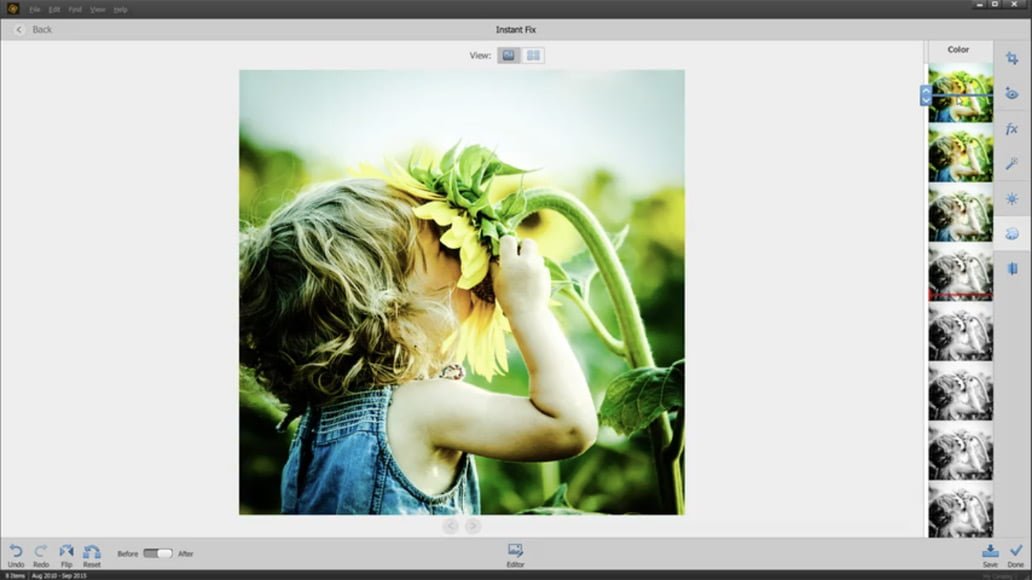
- More affordable than the full Photoshop release
- One-time purchase—no subscription!
- Easy-to-follow guided edits for beginners
- Streamlined for quick edits
- Essential photo editing tools
- Relaxed learning curve makes this app quick to get used to
- Limited social media integration
- No lens distortion corrections
- Dated interface
As the name suggests, the program takes the main elements in Photoshop and Lightroom and combines them into a quick, easy-to-learn program.
It does just about everything a casual photographer needs, from photo organization and basic edits to object removal, layers, and even skin smoothing.
Adobe Photoshop Elements also happens to be extremely user-friendly. In fact, it’s designed especially for beginners and by far the easiest to learn of all of Adobe’s photo editing software.
The home screen allows you to choose between the photo organizer and photo editor, as well as offering Guided Edit options for inspiration.
It also offers a number of slideshows and collages automatically curated by Adobe’s Sensei AI. Sensei also tags and sorts your photos for you (though it helps if you do at least some of the tagging yourself).
The key advantage of Photoshop Elements over Lightroom is the attractive one-time fee – you can buy Elements for the equivalent price of just 10 months of Lightroom subscription.
(Unless you keep paying for the Lightroom subscription, you can’t continue to use the software – you never actually own Lightroom – it’s like you’re paying to use it.
The photo editor in Elements provides three editing modes: Quick Edit, Guided Edits, and Expert. Quick Edit and Guided Edits do a lot of the heavy lifting for you.
Expert level, on the other hand, offers a lot of the manual control you can find in Photoshop, like layers, healing brushes, and paintbrushes. You can’t, however, perform more complex editing tasks such as frequency separation… but this won’t affect the average photographer.
One thing of note is that Photoshop Elements doesn’t have any iCloud or Photos integration, nor is it part of Adobe’s Creative Cloud ecosystem.
So while it makes slide shows and other photo montages easy to share on social media, you’ll be missing out on Adobe’s broader connectivity.
Elements is like Photoshop’s baby brother – if you want to compare Photoshop to Elements, it’s a bit like choosing between a high-end flagship camera with advanced features and a basic but user-friendly point-and-shoot camera.
While both can help you take photos, the professional-grade camera will have more advanced capabilities and features. In contrast, the point-and-shoot camera will be more accessible and easier to use.
What is Adobe Lightroom Classic?
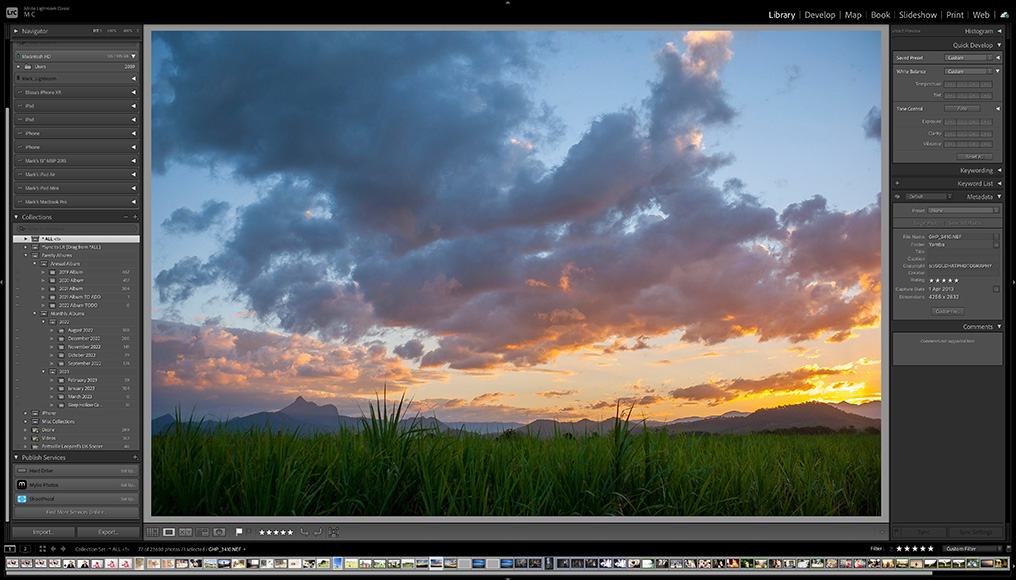
- Powerful non-destructive photo editing tools
- Powerful file management/cataloging system
- Simple syncronised editing
- Excellent cloud syncing/mobile workflow
- Excellent Lightroom Mobile App
- Powerful search tools
- Excellent camera & lens corrections
- Simple book, slide shows & gallery creation
- Great people/face recognition (Sensei)
- Broad plugin & preset support
- Wide support for new cameras
- Subscription payment
- Can be slow on under-powered computers
- File storage can be confusing for beginners
- Lightroom CC lacks features
Adobe Lr Classic has long been the photo editor of choice for professional photographers.
It’s designed to streamline a photographer’s workflow from start to finish and provides industry-leading tools for photo organization, post-processing, exporting, and printing.
One of Lightroom’s key features is non-destructive editing – any changes you make are kept separate from the original photo.
Not only can you save many different iterations of the same image, but you can also go back as many steps as you like at any point in the editing process.
Lightroom also provides advanced Raw file conversion and makes it easy to post-process hundreds of shots with just a few clicks. It’s also been around a while and has a number of stellar presets and plugins available both free and commercially.
(It’s worth noting that Photoshop also has a selection of plugins too.)
Many professional photographers use Lightroom exclusively. Those that don’t tend to subscribe to Adobe’s Photography Plan, which allows them to use Photoshop whenever they need to do a deep dive into an image.
Lightroom belongs to Adobe’s Creative Cloud ecosystem, and a subscription comes with cloud storage, a mobile app, Adobe Portfolio, and many other perks.
You can only get Lightroom as part of a Photography Plan, which includes access to Photoshop. (You can the Lightroom pricing for the latest costs in your currency.)
Let’s Compare Adobe Lightroom to Elements
While both Adobe Photoshop Elements and Adobe Lightroom can turn out some excellent photos, there are some key differences between them. Here’s how they stack up against each other in some key points.
1. Ease of Use

Recently Adobe has focused on making Elements as easy to use as possible. It comes with interactive step-by-step Guided Edits, a number of tutorials available within the interface, and plenty of online documentation.
You honestly don’t need to know anything about photo editing to get started. Simply open up the program and start with the AI-driven automatic edits, or work step-by-step through the Guided Edits.
If you want more control, there’s an Expert mode that brings many of Photoshop’s tools to your fingertips, including editing with layers and masks, object removal, color correction, adding vignettes, text, and healing brushes.
Lightroom, on the other hand, is considerably more complex. There’s a lot under the hood, and while the tools are fairly straightforward, there’s a lot to learn.
If you’re a professional photographer or a serious amateur who takes a lot, then the workflow will matter to you, and learning Lr will be well worth your time.
But if you’re just a casual shooter who just wants to make their images look cool, Elements is definitely a better choice.
2. Raw Photo Conversion
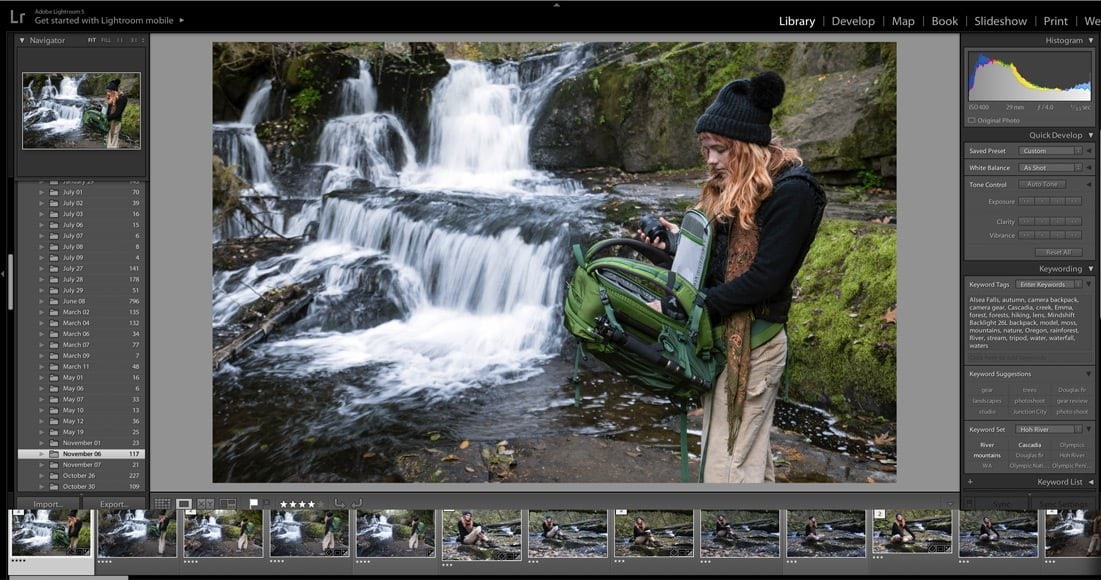
While both programs are capable of Raw conversion, Photoshop Elements goes through Camera Raw.
Not only does this create an extra step in one’s workflow, but Camera Raw’s range of controls is somewhat more limited than Lightroom’s.
Lightroom, on the other hand, is designed for Raw conversion. Not only is the image quality of Raw conversions much better than that of Photoshop Elements, but Lr also offers much more nuanced controls, including local adjustments.
3. Photo Organizing

if you’re a casual shooter with lots of photos and just need basic photo organization, Photoshop Elements should meet all of your needs admirably. Sensei AI does a fantastic job of recognizing faces and other details in your photos.
If you take the time to add names or keyword tags to your images, the image search becomes especially fast.
All this being said, Photoshop Elements isn’t designed for professional use. If you regularly have hundreds of photos from each photoshoot, you’ll probably need the more in-depth photo management that Lr offers.
Lightroom’s important metadata options allow for an extraordinary level of information input. The search capacities are also much more in-depth. You can search by any part of an image’s metadata, including by which camera and/or lens you used.
If you want AI face-recognition capacities, though, you’ll need to use Lightroom CC, as Classic doesn’t yet have that.
4. Editing Tools

One key difference between the two programs is that Photoshop Elements tends to resemble Photoshop more than it does Lr. This is great for those interested in graphic design or looking to create unique image collages.
The program comes with layers and layer masks, a smart healing brush, text options, a powerful refine-edge tool, and many other photoshop staples. It even includes actions for creating a specific editing sequence.
The Sensei AI’s automatic selection and photo colorization both work surprisingly well. It’s now remarkably easy to cut a subject out from its background and vice versa.
Lightroom, on the other hand, was created with photography in mind. While powerful, the adjustments limit themselves to features to those photographers to bring out the best in their images, like tone, sharpness, noise, and lens corrections.
5. Special Effects

If you’re a lover of special effects and one-click editing options, Photoshop Elements comes pretty well loaded. Its Sensei AI helps with colorizing photos, skin smoothing, quick background replacement, and a whole host of other adjustments.
Creating double exposures ( a photo within a photo), adding text, and incorporating border overlays are all easily available.
Elements also automatically creates slideshows and collages of your best photos via Sensei AI and makes them easy to share.
Lightroom, on the other hand, is more focused on photo editing.
There are plenty of presets available for different effects and it has superior black and white conversion, but it’s not really catering to those looking for special effects per se. It’s really much more about manual editing.
If Instagram-like special effects are what you’re looking for, Elements is the clear winner.
6. Cloud Integration
One huge difference between the two programs is Cloud connectivity.
Cloud storage is included with any Lr subscription. You can choose less or more or just to keep images on your desktop, but some is always available. If you choose to keep your images in the Cloud, they’re automatically backed up by Adobe.
If you buy Photoshop Elements, you’ll need to store your images on a local device and back them up yourself. But this doesn’t mean you’re free from Adobe’s system.
Any time you shut off your computer and then restart, you’ll need to log in via your Adobe ID to access the program. (Lr has its own inconveniences in this vein if you’re not in an internet-rich area – you have to log on at least once every 99 days to keep it working.)
Still, if cloud storage is important to you, Lightroom is the clear winner.
7. Price
At a one-time fee of less than $100, Photoshop Elements is a great deal.
Pair it with its sibling video editing software, Premiere Elements ($149.99), and you’re really getting a steal – if it does everything you need.
The two Lr Classic options are both relatively affordable but require subscriptions.
So, how much does Lightroom cost exactly?
The 20GB photography plan includes Lr Classic, Lr CC (for mobile users), Photoshop, and 20 GB of cloud storage. It’s the best deal if you’re storing your images on a local drive or don’t tend to have a lot of images. It costs $119.88/yr
(There’s also a 1TB plan which includes more storage but is even more expensive.)
Lightroom CC is a bit different to Classic, and you’ll want to make sure that CC will meet all of your needs before choosing that plan – check out this guide which explains this in more detail.
In the end, it really depends on what you’re looking for.
If you’re a casual photographer and Elements meets all your editing needs, it’s a fantastic deal – especially as there’s no subscription.
Photoshop Elements’ image editing abilities are getting more and more powerful and Sensei performs admirably.
Frequently Asked Questions
Does Lightroom work with Photoshop Elements?
No, Lightroom and Photoshop Elements are completely different programs and aren’t linked together in any way. You’ll need to choose one or the other.
Is Photoshop Elements the same as Photoshop?
No, it contains many components of Photoshop but lacks many of the more advanced features.
What is the difference between Photoshop Elements and Lightroom?
Elements was designed for novice and casual photographers. It comes with many one-click edits, lots of guidance, and special effects. It also includes a number of graphic design components that Lightroom doesn’t have.
Lightroom was designed for professional photographers and assumes that you will be manually editing your photos. When combined with Photoshop in the Photography plan, Lightroom users gain complete control over every aspect of their photos.
Photoshop Elements vs Lightroom Classic | Final Words
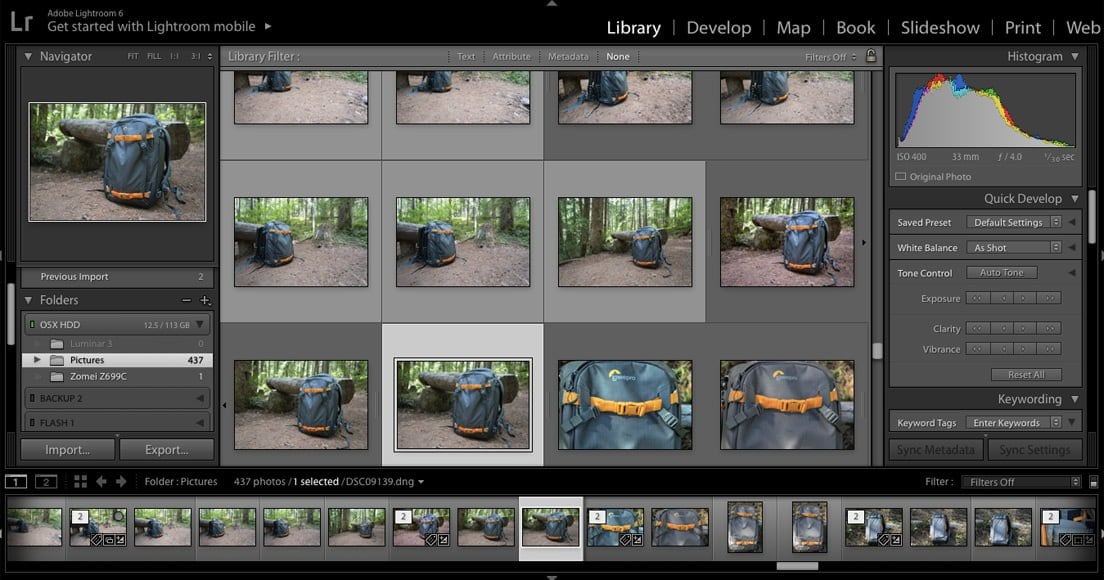
If you’re still wondering which program is right for you, consider it this way:
Suppose you’re wanting a program that is both easy to use and contains tools for making fundamental changes to your images (like cutting out the background or removing large objects).
In that case, Photoshop Elements is likely for you.
It’s also a great choice if you’re wanting a program that is more like Photoshop, but you’re not really wanting to pay for the Photoshop subscription.
Elements is also a great choice if you’re looking to effortlessly create collages and slideshows or spiff up your family photos with neat little backgrounds or special effects.
On the other hand, if you shoot in Raw, want complete control over the editing of your images, don’t mind the Adobe subscription model, and/or aspire to become a pro, Lr Classic is clearly the better choice.
It’s also better for those who prefer to store their images in the cloud.
If you’re thinking in terms of Lightroom vs Photoshop, Adobe’s Photography Plan is also a great choice for those who want to have to choose between the two. It’s really a great price, especially considering that it includes all updates.
There’s definitely something to be said for having both the excellent Raw conversion, photo organization, and workflow options of Lightroom while being able to use Photoshop for deep surgery/graphic design on your images when the situation calls for it.
In the end, if you’re a serious photographer or looking to become one, Lightroom really is the way to go.
Photoshop Elements has a number of nice beginner-friendly features and graphic design options, but Lightroom is where it’s at in terms of getting the most out of your images.
Overall, while both programs are great, Adobe Lightroom is the overall winner based on the sheer number of features it provides.

Lightroom is a much better all round photo editing and management software than Elements.
Tip: The 20GB Photography Plan is best value








